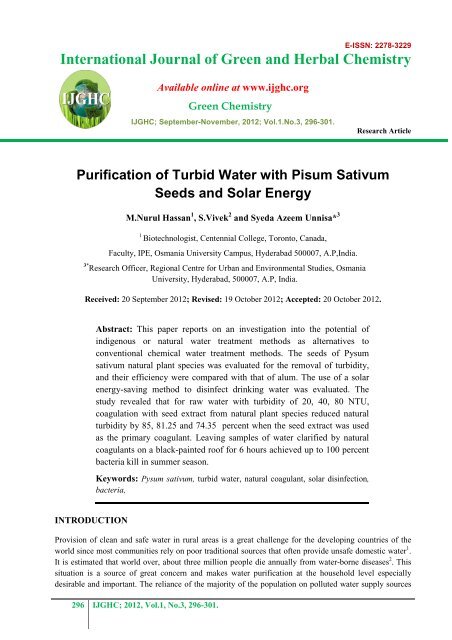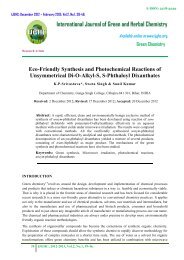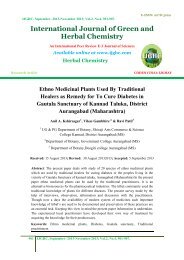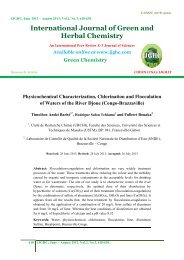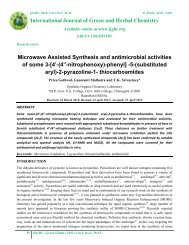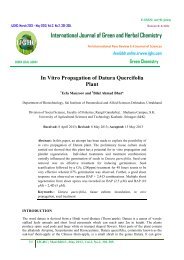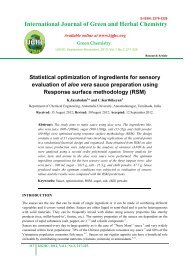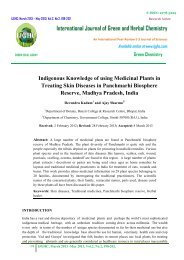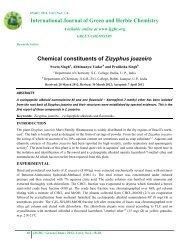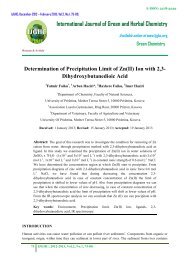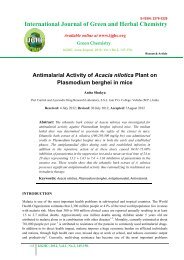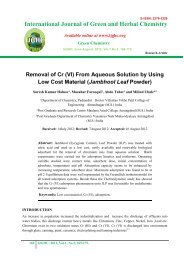Purification of Turbid Water with Pisum Sativum Seeds and ... - IJGHC
Purification of Turbid Water with Pisum Sativum Seeds and ... - IJGHC
Purification of Turbid Water with Pisum Sativum Seeds and ... - IJGHC
Create successful ePaper yourself
Turn your PDF publications into a flip-book with our unique Google optimized e-Paper software.
E-ISSN: 2278-3229<br />
International Journal <strong>of</strong> Green <strong>and</strong> Herbal Chemistry<br />
Available online at www.ijghc.org<br />
Green Chemistry<br />
<strong>IJGHC</strong>; September-November, 2012; Vol.1.No.3, 296-301.<br />
Research Article<br />
<strong>Purification</strong> <strong>of</strong> <strong>Turbid</strong> <strong>Water</strong> <strong>with</strong> <strong>Pisum</strong> <strong>Sativum</strong><br />
<strong>Seeds</strong> <strong>and</strong> Solar Energy<br />
M.Nurul Hassan 1 , S.Vivek 2 <strong>and</strong> Syeda Azeem Unnisa* 3<br />
1<br />
Biotechnologist, Centennial College, Toronto, Canada,<br />
Faculty, IPE, Osmania University Campus, Hyderabad 500007, A.P,India.<br />
3* Research Officer, Regional Centre for Urban <strong>and</strong> Environmental Studies, Osmania<br />
University, Hyderabad, 500007, A.P, India.<br />
Received: 20 September 2012; Revised: 19 October 2012; Accepted: 20 October 2012.<br />
Abstract: This paper reports on an investigation into the potential <strong>of</strong><br />
indigenous or natural water treatment methods as alternatives to<br />
conventional chemical water treatment methods. The seeds <strong>of</strong> Pysum<br />
sativum natural plant species was evaluated for the removal <strong>of</strong> turbidity,<br />
<strong>and</strong> their efficiency were compared <strong>with</strong> that <strong>of</strong> alum. The use <strong>of</strong> a solar<br />
energy-saving method to disinfect drinking water was evaluated. The<br />
study revealed that for raw water <strong>with</strong> turbidity <strong>of</strong> 20, 40, 80 NTU,<br />
coagulation <strong>with</strong> seed extract from natural plant species reduced natural<br />
turbidity by 85, 81.25 <strong>and</strong> 74.35 percent when the seed extract was used<br />
as the primary coagulant. Leaving samples <strong>of</strong> water clarified by natural<br />
coagulants on a black-painted ro<strong>of</strong> for 6 hours achieved up to 100 percent<br />
bacteria kill in summer season.<br />
Keywords: Pysum sativum, turbid water, natural coagulant, solar disinfection,<br />
bacteria,<br />
INTRODUCTION<br />
Provision <strong>of</strong> clean <strong>and</strong> safe water in rural areas is a great challenge for the developing countries <strong>of</strong> the<br />
world since most communities rely on poor traditional sources that <strong>of</strong>ten provide unsafe domestic water 1 .<br />
It is estimated that world over, about three million people die annually from water-borne diseases 2 . This<br />
situation is a source <strong>of</strong> great concern <strong>and</strong> makes water purification at the household level especially<br />
desirable <strong>and</strong> important. The reliance <strong>of</strong> the majority <strong>of</strong> the population on polluted water supply sources<br />
296 <strong>IJGHC</strong>; 2012, Vol.1, No.3, 296-301.
<strong>Purification</strong>...<br />
M.Nurul Hassan et al.<br />
poses a great risk to health 3 . These sources are heavily polluted by animal excretions, human excreta, <strong>and</strong><br />
sewage effluents. Fecal pollution <strong>of</strong> water supplies is attributed to poor disposal <strong>of</strong> excreta <strong>and</strong> a low<br />
st<strong>and</strong>ard <strong>of</strong> community hygiene. Conventional water treatment relies on the addition <strong>of</strong> chemicals such as<br />
alum (aluminum sulfate) as coagulants <strong>and</strong> the addition <strong>of</strong> chlorine as a bactericide 4 . The availability <strong>of</strong><br />
these chemicals, which depends on foreign exchange, is unreliable <strong>and</strong> unpredictable. Because <strong>of</strong><br />
economic <strong>and</strong> political constraints, the universal provision <strong>of</strong> piped water is not currently feasible 5 . This<br />
circumstance leaves millions <strong>with</strong>out access to safe drinking water. Interim solutions are clearly needed.<br />
The purpose <strong>of</strong> our study was to evaluate the potential <strong>of</strong> traditional treatment methods (i.e., those based<br />
on local knowledge inherited from previous generations). The study used plant materials (seeds) <strong>of</strong> Pysum<br />
sativum plant for turbidity removal <strong>and</strong> used sterilization <strong>of</strong> water by solar energy for destruction <strong>of</strong><br />
bacteria, <strong>and</strong> compared the results <strong>with</strong> those <strong>of</strong> st<strong>and</strong>ard treatment practices.<br />
MATERIALS AND METHODS<br />
Model turbid water: A stock <strong>of</strong> synthetic turbid water samples was prepared by suspending 10g <strong>of</strong><br />
Kaolin in 1L <strong>of</strong> tap water. The suspension was stirred for 30 minutes <strong>and</strong> left to st<strong>and</strong> for 24hrs to hydrate<br />
particles. The desire turbidity <strong>of</strong> 20 NTU (low), 40 NTU (medium) <strong>and</strong> 80 NTU (high) was prepared by<br />
mixing a fraction <strong>of</strong> decanted kaolin suspension <strong>with</strong> tap water. The pH <strong>of</strong> synthetic water samples was<br />
maintained constant at 7.0. E.coli was mixed in stock turbid water from preserve lab culture samples.<br />
Natural coagulant preparation: <strong>Seeds</strong> were collected from nearby market. Dissections <strong>of</strong> the seed pods<br />
were performed by h<strong>and</strong>: The seeds were removed from the pods <strong>and</strong> were dried in the hot sun. Fine<br />
powder was made by using mortar <strong>and</strong> pestle <strong>and</strong> was stored in air tighten packets for future use. The<br />
scientific names <strong>and</strong> coagulating active agent is presented in Table 1.<br />
Table -1: Scientific names <strong>and</strong> active component in agro based seeds<br />
Scientific Name <strong>Seeds</strong> Photo Active Agent<br />
Pysum sativum<br />
Albumin proteins <strong>and</strong> starch<br />
Solar exposure time: Poly Ethylene Terephtalate (PET) bottles made <strong>of</strong> transparent, clear plastic,<br />
cylinder shape <strong>with</strong> a surface area <strong>of</strong> 23 × 7.2 × 6.0 cm was used for experimental purpose as they are<br />
good transmitters <strong>of</strong> light in the UV <strong>and</strong> visible range <strong>of</strong> the solar spectrum. The total exposure time <strong>of</strong><br />
experiments varied from 1 to 6 hours.<br />
Analytical measurements: <strong>Turbid</strong>ity was measured using a calibrated ELICO CL 52D <strong>Turbid</strong>ity meter to<br />
measure the turbidity <strong>of</strong> the solution in Nephelometric <strong>Turbid</strong>ity Units (NTU). pH , temperature <strong>and</strong><br />
alkalinity was measured by physico-chemical methods.<br />
Microbial analysis: Microbial analysis was done by st<strong>and</strong>ard methods. The Escherichia coli counts were<br />
enumerated on eosin methylene blue after 0.1 milliliters <strong>of</strong> the turbid water samples was aseptically serial<br />
diluted up to three fold. Samples were analyzed before <strong>and</strong> after treatment for its potability using 6,7<br />
method. The colonies are enumerated by using digital colony meter <strong>and</strong> the log reduction is given by the<br />
following formula.<br />
297 <strong>IJGHC</strong>; 2012, Vol.1, No.3, 296-301.
<strong>Purification</strong>...<br />
M.Nurul Hassan et al.<br />
No. Of colonies formed<br />
1<br />
Cfu/ml =<br />
Sample plated<br />
X<br />
Dilution factor<br />
EXPERIMENTAL<br />
Experimental works evaluate the efficiency <strong>and</strong> the coagulation effect <strong>of</strong> the coagulant extract from<br />
Pysum sativum based seeds by using jar test method for summer <strong>and</strong> rainy seasons -2009. Coagulation<br />
tests were conducted <strong>with</strong> jar-test equipment, which has a base floc illuminator. Flash mixing time (at 100<br />
rpm) was 1 minute <strong>and</strong> flocculation time (at 40 rpm) was 15 minutes. The samples were then allowed to<br />
settle for various intervals <strong>of</strong> time, after which the water samples were examined for physical <strong>and</strong><br />
chemical quality parameters <strong>and</strong> the lowest dose <strong>of</strong> coagulant that gave satisfactory turbidity reduction <strong>of</strong><br />
the water was established. Physical <strong>and</strong> chemical parameters <strong>of</strong> raw <strong>and</strong> clarified water — pH <strong>and</strong><br />
alkalinity were determined according to st<strong>and</strong>ard methods. <strong>Turbid</strong>ity was determined by the<br />
Nephelometric method <strong>with</strong> a turbidity meter. Plastic 1,000-mL bottles were filled to the 1,000-mL mark<br />
<strong>with</strong> water clarified by natural coagulants, <strong>and</strong> the lids were put on. The bottles were then put on a blackpainted<br />
ro<strong>of</strong>, where they stayed for different periods <strong>of</strong> time, after which the water samples were<br />
examined for microbial numbers according to the st<strong>and</strong>ard plate count method.<br />
RESULTS AND DISCUSSION<br />
Results <strong>of</strong> the treated samples from natural coagulant Pysum sativum <strong>and</strong> solar disinfection are shown in<br />
Figure 1, 2.1, 2.2, 2.3 <strong>and</strong> 3.1, 3.2, 3.3. Jar test method for natural coagulant (Pysum sativum) showed<br />
high turbidity reduction <strong>and</strong> high coagulant activity in samples treated as it contain active ingredient<br />
starch, which is non-ionic polymer which forms positive <strong>and</strong> negative ions in water <strong>and</strong> the mechanisms<br />
<strong>of</strong> coagulation is by bridging. For summer season an optimum dose <strong>of</strong> 0.2 g/l <strong>of</strong> this coagulant resulted in<br />
85, 81.25 percent <strong>with</strong> 60 minute settling time for 20 <strong>and</strong> 40 NTU <strong>and</strong> 75.35 percent in 120 minute for 80<br />
NTU. Further clarified water <strong>with</strong> Pysum sativum was exposed to sunlight which showed 100 percent<br />
inactivation <strong>of</strong> both E.coli <strong>and</strong> Coliforms counts <strong>with</strong>in one hour, <strong>with</strong> no subsequent reactivation <strong>of</strong><br />
growth after 24 hours in treated water sample when compared to control. Whereas, in rainy season an<br />
optimum dose <strong>of</strong> 0.2 g/l <strong>of</strong> this coagulant resulted in 83.75, 78 percent <strong>with</strong> 60 minute settling time for 20<br />
<strong>and</strong> 40 NTU <strong>and</strong> 73 percent in 120 minute for 80 NTU. Further clarified water <strong>with</strong> Pysum sativum was<br />
exposed to sunlight which showed less percent inactivation <strong>of</strong> both E.coli <strong>and</strong> Coliforms counts <strong>with</strong>in<br />
three hour <strong>of</strong> exposure <strong>with</strong> subsequent reactivation <strong>of</strong> growth after 24 hours in control <strong>and</strong> treated water<br />
samples. Pysum sativum seeds resulted in producing treated water <strong>with</strong> turbidity more than 5 NTU as per<br />
WHO guidelines. Therefore either they can be used as primary coagulant (or) coagulant aid in relation to<br />
alum. pH was retained at 7.0 before <strong>and</strong> after treatment <strong>with</strong> natural coagulant <strong>and</strong> alum. Initial alkalinity<br />
was found to be 230-300mg/l <strong>and</strong> decreased to 180-200 mg/l <strong>with</strong> treatment. These coagulants are from<br />
agro based seeds if when mixed <strong>with</strong> the water does not release any constituents that are harmful to health<br />
<strong>and</strong> no objectionable taste <strong>and</strong> odour nor increase in the concentration <strong>of</strong> TDS was observed.<br />
Whereas water clarified <strong>with</strong> natural coagulant when exposed to solar disinfection in summer season<br />
showed drastic inactivation <strong>of</strong> E.coli <strong>and</strong> Coliforms in treated sample when compared to rainy season.<br />
The active agent is a water-soluble cationic protein that harbours very good coagulation properties which<br />
is used in extremely low dosages than that used for crude seed extract 8 . Also, water treated by pure<br />
proteins is not prone to bacterial re-growth. The researchers thus affirmed that, the isolation <strong>and</strong><br />
purification <strong>of</strong> active agents from the seed is relatively easy compared to laborious manipulation <strong>of</strong> other<br />
proteins <strong>and</strong> thus recommended it for use in water treatment processes. Studies have shown that synergies<br />
from the combined application <strong>of</strong> radiation <strong>and</strong> thermal treatment have a significant effect on the die-<strong>of</strong>f<br />
rate <strong>of</strong> micro organisms. <strong>Turbid</strong>ity is a significant factor in the disinfection process. The effectiveness <strong>of</strong><br />
298 <strong>IJGHC</strong>; 2012, Vol.1, No.3, 296-301.
<strong>Purification</strong>...<br />
M.Nurul Hassan et al.<br />
solar disinfection has been tested on samples <strong>with</strong> turbidities ranging from less than 10 NTU to<br />
approximately 300 NTU. Researchers have found that higher turbidity samples exposed to sunlight<br />
attained consistently higher water temperatures, which was attributed to absorption <strong>of</strong> radiation by the<br />
particulate matter 9 . More turbid samples, at 300 NTU, also had less inactivation <strong>of</strong> E.coli compared to<br />
samples <strong>with</strong> little or no turbidity. This may be in part due shielding <strong>of</strong> organisms by particles 10 . Less than<br />
1.6<br />
Various turbidities removed by P ys um s ativum <strong>and</strong> alum<br />
1.4<br />
O p ti m u m D o s a g e (g /l )<br />
1.2<br />
1<br />
0.8<br />
0.6<br />
0.4<br />
0.2<br />
20NTU<br />
40NTU<br />
80NTU<br />
0<br />
Alum<br />
P eas<br />
s ummer<br />
P eas rainy<br />
1 % <strong>of</strong> the total incident UV light is able to penetrate beyond a water depth <strong>of</strong> 2cm from the surface in<br />
samples <strong>with</strong> turbidities greater than 200 NTU 11 . Therefore, it may be necessary to filter turbid waters<br />
before sun exposure.<br />
Fig.1: Treatment <strong>of</strong> turbid water by natural coagulant – summer season<br />
20NT U<br />
40NT U<br />
80NT U<br />
25<br />
C o l o n i e s p e r 1 0 0 M L<br />
20<br />
15<br />
10<br />
5<br />
0<br />
B .T A .T S .D<br />
E .coli<br />
C oliforms<br />
40<br />
35<br />
C o l o n i e s p e r 1 0 0 m l<br />
30<br />
25<br />
20<br />
15<br />
10<br />
5<br />
0<br />
B .T A.T S .D<br />
E .coli<br />
C oliforms<br />
50<br />
C o l o n i e s p e r 1 0 0 m l<br />
40<br />
30<br />
20<br />
10<br />
0<br />
B .T A.T S .D<br />
E .coli<br />
C oliforms<br />
Fig.2.1. Fig.2.2. Fig.2.3.<br />
Fig. 2.1, 2.2, <strong>and</strong> 2.3: Inactivation <strong>of</strong> bacteria in 1 hr by solar disinfection from water clarified <strong>with</strong><br />
Pysum sativum for various turbidities –summer season<br />
BT – Before treatment, AT- After treatment, SD- solar disinfection<br />
299 <strong>IJGHC</strong>; 2012, Vol.1, No.3, 296-301.
<strong>Purification</strong>...<br />
M.Nurul Hassan et al.<br />
20NTU<br />
40NT U<br />
80NT U<br />
30<br />
35<br />
35<br />
25<br />
C o l o n i e s p e r m l<br />
20<br />
15<br />
10<br />
5<br />
E .c oli<br />
C oliforms<br />
30<br />
C o l o n i e s p e r m l<br />
25<br />
20<br />
15<br />
10<br />
5<br />
E .c oli<br />
C oliforms<br />
30<br />
C o l o n i e s p e r m l<br />
25<br />
20<br />
15<br />
10<br />
5<br />
E .coli<br />
C oliforms<br />
0<br />
B .T A.T S .D<br />
0<br />
B .T A.T S .D<br />
0<br />
B .T A.T S .D<br />
Fig.3.1. Fig.3.2. Fig. 3.3.<br />
Fig. 3.1, 3.2 <strong>and</strong> 3.3: Inactivation <strong>of</strong> bacteria in 3 hr by solar disinfection from water clarified<br />
<strong>with</strong> Pysum sativum for various turbidities –rainy season<br />
CONCLUSIONS<br />
Studies have shown that the combination <strong>of</strong> natural treatment methods using plant seeds (Pysum sativum)<br />
<strong>and</strong> solar disinfection indicate that this method can effectively clarify <strong>and</strong> disinfect household drinking<br />
water, so the use <strong>of</strong> natural coagulants that are locally available in combination <strong>with</strong> solar radiation, which<br />
is abundant <strong>and</strong> inexhaustible, provides a solution to the need for clean <strong>and</strong> safe drinking water in the<br />
rural communities.<br />
ACKNOWLEDGEMENTS<br />
The authors thank the Department <strong>of</strong> Science Technology (DST) who has granted project under water<br />
initiative technology, New Delhi.<br />
REFERENCES<br />
1. K.A.Ghebremichael, K.R,Gunaratna, H. Henriksson, Brumer <strong>and</strong> G. Dalhammar; <strong>Water</strong> Research<br />
2005; 39: 2338- 2344.<br />
2. World Health Organisation, <strong>Water</strong> for Life: making it happens, Geneva: Switzerl<strong>and</strong>, 2005.<br />
3. Ozacar M <strong>and</strong> Sengil A. Physicochemical Engineering Aspects 2003; 29: 85- 96.<br />
4. D.J.Lye, J.<strong>Water</strong> Research 2002: 38: 1301 - 1306.<br />
5. M.D.Sobsey, <strong>Water</strong> Health 2006; 4: 17 – 21.<br />
6. St<strong>and</strong>ard Methods for the Examination <strong>of</strong> <strong>Water</strong> <strong>and</strong> Wastewater, American Public Health<br />
Association (20 th ed.), AWWA <strong>and</strong> WEF, Washington, 1983.<br />
7. M. Cheesbrough, Medical laboratory manual for Tropical Health Technology, USA, 1984.<br />
8. S.C.Kehoe,M.R. Barer,L.O. Devlin <strong>and</strong> K.G. Mcguigan,. Applied Microbiology 2004; 38: 410-<br />
414.<br />
300 <strong>IJGHC</strong>; 2012, Vol.1, No.3, 296-301.
<strong>Purification</strong>...<br />
M.Nurul Hassan et al.<br />
9. M.Berney, H. Weilenmann, A. Simonetti <strong>and</strong> T. Egli , Journal <strong>of</strong> Applied Microbiology 2006:<br />
101; 828 – 836.<br />
10. R.M.Conroy , M.E. Meegan, T. Joyce,K. McGuigan, <strong>and</strong> J.Barnes, Arch. Disabled. Child, 2001;<br />
85: 293-295.<br />
11. Syeda Azeem Unnisa, P.Deepthi <strong>and</strong> K.Mukkanti, Sciencia Acta Xaveriana 2010; 1: 1-13.<br />
*Correspondence Author: Syeda Azeem Unnisa; Research Officer, Regional Centre for<br />
Urban <strong>and</strong> Environmental Studies, Osmania University, Hyderabad, 500007, A.P, INDIA<br />
E-mail:syeda_30@yahoo.co.in.<br />
301 <strong>IJGHC</strong>; 2012, Vol.1, No.3, 296-301.


